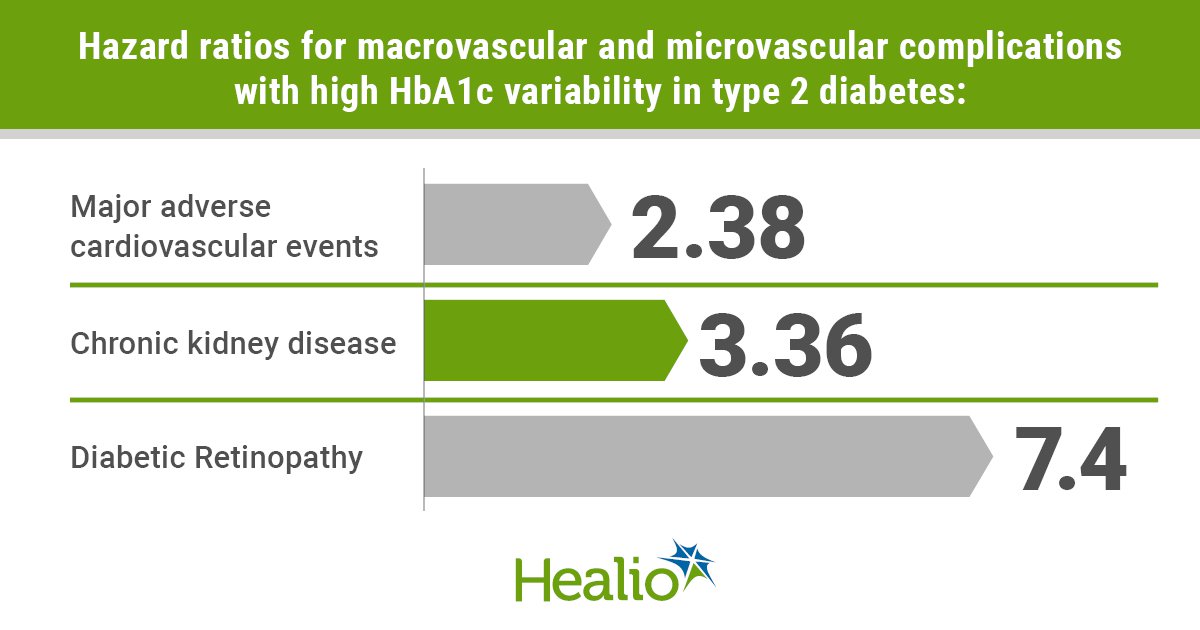Cardiovascular risks amplified by HbA1c variability in type 2 diabetes
Adults with type 2 diabetes may be at greater risk for major adverse cardiovascular events and microvascular complications if they frequently experience changes in HbA1c of 0.5% or more, according to findings presented at the European Association for the Study of Diabetes Annual Meeting.

“The main take-home message for diabetes physicians and general practitioners involving diabetes management is to let them know that the fluctuation of HbA1c level throughout the diabetes management is associated with the prognosis of diabetes,” Sheyu Li, MD, an endocrinologist at West China Hospital, Sichuan University, told Endocrine Today. “Higher HbA1c variability is associated with higher risks of macro- and microvascular complication of diabetes and death independent of the time-weighted average HbA1c.”
Using data from residents of Tayside and Fife in the Scottish Care Information-Diabetes Collaboration, Li and colleagues conducted a retrospective review and identified instances of major adverse cardiovascular events, all-cause mortality, cardiovascular death, coronary artery disease, ischemic stroke, heart failure, diabetic retinopathy, diabetic peripheral neuropathy, diabetic foot ulcer and chronic kidney disease among 13,111 to 19,883 participants (depending on comorbidity) with type 2 diabetes. All participants in the analysis had available data from the time of diabetes diagnosis and at least five Hba1c readings, which were used to calculate HbA1c variability score, the percentage of times HbA1c changed by more than 0.5% between readings.

Major adverse cardiovascular event risk was more than doubled for participants with HbA1c variability score between 80% and 100% compared with those with 20% or less variability (HR = 2.38; 95% CI, 1.61-3.53). All-cause mortality risk (HR = 2.4; 95% CI, 1.72-3.33), cardiovascular death risk (HR = 2.4; 95% CI, 1.13-5.11), ischemic stroke risk (HR = 2.04; 95% CI, 1.12-3.73) and CAD risk (HR = 2.63; 95% CI, 1.81-3.84) were also more than doubled for those with variability between 80% and 100% compared with those with 20% or less variability. Heart failure risk (HR = 3.23; 95% CI, 1.76-5.93), diabetic peripheral neuropathy risk (HR = 3.07; 95% CI, 2.23-4.22) and CKD risk (HR = 3.36; 95% CI, 2.37-4.76) were more than tripled for those with variability between 80% and 100% compared with those with 20% or less variability. In addition, diabetic foot ulcer risk was five times higher (HR = 5.24; 95% CI, 2.61-10.49) and diabetic retinopathy risk was seven times higher (HR = 7.4; 95% CI, 3.84-14.27) for those with highest vs. lowest variability.
“Most current practice guidance emphasizes the importance of controlling HbA1c to the target of the patients. Our study draws the attention of HbA1c fluctuation independent of the average HbA1c,” Li said. “When we are trying to control the HbA1c to target in our patients, we need to put an eye on their HbA1c changes from visit to visit.” – by Phil Neuffer
References:
Li S. Abstract 1190. Presented at: European Association for the Study of Diabetes Annual Meeting; Sept. 16-20, 2019; Barcelona.
For more information:
Sheyu Li, MD, can be reached at lisheyu@gmail.com.
Disclosures: The study was supported by the International Visiting Program for Excellent Young Scholars of SCU. Li reports no relevant financial disclosures.

